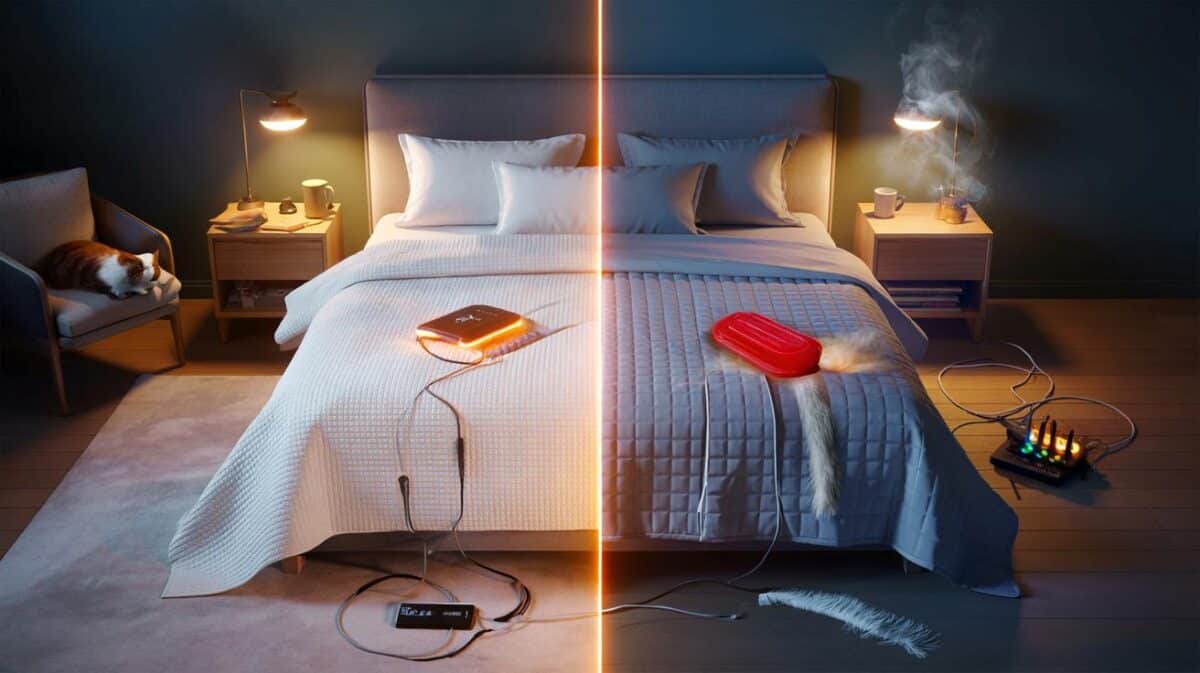The cold doesn’t shout. It creeps, slides into gaps, stiffens pipes, and waits for the quiet hour when the house exhales and the boiler dozes. That’s when a split pipe, a frozen condensate, or a dead pump turns a peaceful night into a frantic mop-and-bucket sprint. A two-minute checklist before bed can stop the drama.
A hairline stream ran from the skirting like a thread pulled from a jumper, widening into a cold lake under the stair cupboard. The homeowner kept saying, “It was fine at midnight, I swear.” Outside, the frost was the kind that turns wheelie bins glittery and locks garden gates. Inside, a humble 15mm pipe had burst behind the washing machine, and all the late-night Google searches in the world couldn’t put that water back in. The house hummed with wet radiators and panic. Something simple had been missed. A small habit. One we forget until it costs us.
Why nights go wrong when temperatures plunge
Most winter disasters happen when no one’s watching. At night, the heating drops, demand quietens, and cold air finally wins the slow battle across lofts, porches, and north-facing corners. Pipes that run along external walls lose heat faster, especially ones that already struggle with thin lagging or draughts. The boiler’s condensate can freeze in its outdoor section, the pump trips, the flame goes out, and your frost protection never even gets to play hero. Little imbalances stack up. By morning, you meet them all at once.
One London plumber told me his phone lights up between 5 and 7 a.m. after a hard frost. It tracks the first feet hitting cold floors, the first twist of a tap, the first jolt of “no heat.” Water companies say winter call-outs for broken pipes surge after back-to-back freezing nights, not the first one. A single burst can gush up to 30 litres a minute. That’s a bathtub in less than ten. We’ve all had that moment when the sound behind a wall changes pitch and your stomach drops.
The physics is ugly but simple. Water expands as it freezes, pushing at copper and plastic that don’t want to give. It’s often the thaw that finishes the job: ice recedes, pressure returns, and the split becomes a sprinkler. Heating systems, too, live or die on balance. A stuck valve in the spare room can trick the boiler into thinking all’s well. A frozen external condensate traps the boiler in a sulk until you nurse it back. Night is when equilibrium drifts, unless you give it a nudge.
The quick night-time checklist that buys you a calm morning
First, set your boiler to frost protection or a low overnight programme. Aim for roughly 16–18°C indoors on the coldest nights, not a full bake, just a steady hum. If you’ve a combi, peek at the pressure gauge before bed; most prefer between 1.0 and 1.5 bar when cold. Flick the heating briefly and listen: rads should warm evenly, pump sounds smooth, no clunking. In a cold snap, crack the loft hatch a finger if pipes run up there. A whisper of warm air can keep a borderline pipe above freezing.
Now the easy wins people skip. Turn the outside tap off at the indoor isolation valve and drain what’s left; leave the hose detached. Open cupboard doors under sinks on external walls so heat reaches the pipes. In rooms that barely get used, open the TRV to medium so water keeps moving. Pick one radiator downstairs and keep it on without a TRV completely shut — the system needs a path. Got a condensate that runs outside in skinny pipe? Lag it, and if it’s freezing hard, consider the kettle trick at bedtime for peace of mind. Let’s be honest: nobody really does this every day.
“Ninety seconds before lights out beats nine hours of damage,” says a veteran heating engineer from Leeds. “People think it’s about cranking the heat. It’s actually about flow, balance and knowing your stopcock.”
- Know your stopcock: find it, turn it both ways, make sure it moves. Label it clearly.
- Crack a tap to a slow drip only in extreme, multi-night freezes where pipes have frozen before.
- It’s the quiet habits that save noisy disasters.
- Frost mode saves boilers: check your manual and leave power on overnight.
- One warm room beats many cold ones: concentrate heat where you sleep and where pipes run.
Small choices that cut risk without burning money
Every house has a weak spot. You can spot it by the cold patch on plaster, the cupboard that smells faintly of damp, or the loft corner that bites your fingers first. Draft-proof around pipe penetrations with a bead of sealant, and slide foam lagging over exposed runs in garages, porches and lofts. If your boiler’s condensate exits outdoors, upsize the external section to 32mm and insulate it thickly. Program your smart thermostat to hold a low plateau, not swing wildly between hot and off. The goal is gentle, continuous warmth, not a rollercoaster.
Common missteps are small but loud in consequences. People shut every internal door, starving cold corners of warm air. They max TRVs in one room and close them everywhere else, forcing high pressure through a tiny loop. They forget that a towel piled behind a loo can trap a pipe in a freezer box. If you’re tight on bills, warm the rooms that shelter your pipes, not just the ones you sit in. A litre of prevention costs less than a litre mopped at 3 a.m., and the meter agrees.
It helps to think of your home as a network that wants to circulate, not a collection of isolated boxes. Water hates dead ends. Heat hates sharp drops. If a bedroom rad never wakes, bleed it in daylight and check the lockshield, not at bedtime with a torch and cold fingers. Smart plugs on a small oil-filled radiator can keep a utility or loft corner above 5°C during Arctic blasts, but only with a thermostat and a timer. The checklist is the nightly nudge; the daytime is for fixes that stick. Soyons honnêtes : personne ne fait vraiment ça tous les jours.
| Key points | Detail | Reader Interest |
|---|---|---|
| Stop freezing before it starts | Hold 16–18°C overnight, use frost mode, keep flow paths open | Simple habits beat expensive emergencies |
| Protect weak links | Insulate outdoor condensate, lag exposed pipes, open cold cupboards | Quick DIY jobs with big payback |
| Plan for the “what if” | Learn the stopcock, save a plumber’s number, keep towels and a bucket ready | Confidence when the unexpected hits |
FAQ :
- How cold is “too cold” for pipes?Risk climbs when outdoor temps sit at or below 0°C for hours, especially after back-to-back nights. Exposed or poorly lagged runs can freeze even when indoor rooms feel fine.
- Should I let taps drip overnight?Use a slow drip only during severe, prolonged freezes or if a specific pipe has frozen before. Dripping wastes water, so target the at-risk run, not the whole house.
- What boiler pressure should I see before bed?Most systems like 1.0–1.5 bar when cold. If it’s near zero, top up in daylight and check for leaks. If it creeps over 2.0 bar on heat, talk to an engineer.
- My boiler stopped with a fault code on a freezing morning. What now?Suspect a frozen condensate outside. Thaw the external pipe with warm (not boiling) water, reset the boiler, and consider upsizing and insulating that run.
- What’s the fastest way to shut off water in a burst?Turn the internal stopcock clockwise to close. Open cold taps to drain. Kill electrics if water nears sockets or lights, then call a professional.








